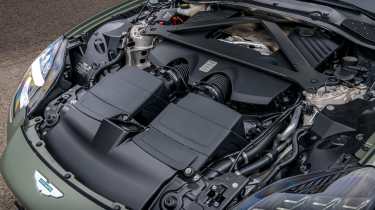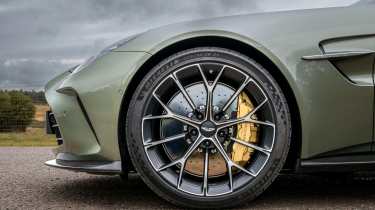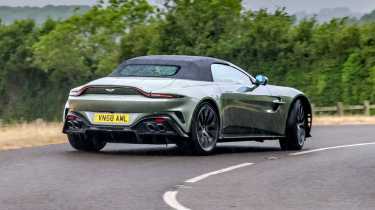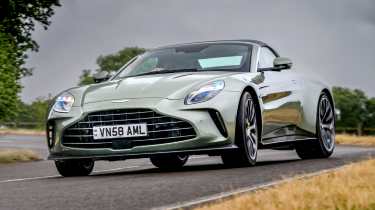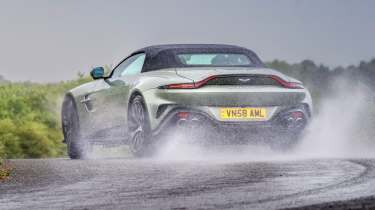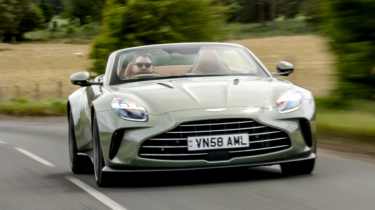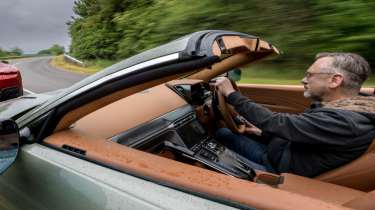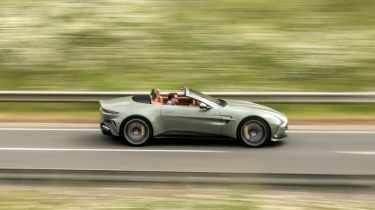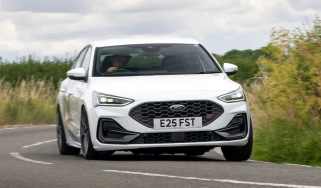Aston Martin Vantage Roadster 2025 review – all-rounder Aston is a Ferrari beater
Developed in tandem with the coupe, the new Vantage Roadster has a welcome sense of togetherness for an open-top sports car
While the new Aston Martin Vantage Roadster was well underway in terms of development before new CEO Adrian Hallmark arrived at Gaydon, it does mark the beginning of his bold new product strategy. And bold is what Aston Martin needs to be. Adding the Roadster to the Vantage line-up certainly broadens the model’s appeal and adds to a range that's already been expanded further with the Vantage S. That joins the new DBX S and will be joined by an upgraded variant of the DB12 that's been spied testing) in short order. Aston's not going full 911, though: where Porsche thinks nothing of offering 20-plus 911 derivatives across three body styles, Aston is sticking with two bodies and two spec levels, standard Vantage and Vantage S, at least for now.
Today’s ‘regular’ Vantage is already a special car. One with a desirability factor that’s now matched with a dynamic repertoire with no excuses. The new £181,500 Roadster needs to stick to the same path. Sharing the coupe’s wheel-at-each-corner, four-square stance, the new Vantage Roadster oozes the same muscular presence, providing the contrast expected between it and the svelte, more elegant open-top DB12 Volante.
Its Z-fold eight-layer fabric roof, when raised, does mean you lose the coupe’s sleek roof-rear window-line and gain a longer rear deck area of bodywork running into the kicked-up tail. It exaggerates the Vantage’s short-wheelbase look and gives the illusion of pushing the cabin forward, too. But the car retains an aggressive advantage over Ferrari’s more sculptured Roma Spider and Porsche’s rather awkward-looking 911 Cabriolet.
Engine, gearbox and technical highlights
- Gains just 60kg in Roadster transformation
- 656bhp, 789lb ft
- 0-62mph 0.1sec slower than the coupe at 3.6sec
More reviews
Group tests
- Ferrari Roma Spider v Aston Martin Vantage Roadster: £200k V8 drop-tops go head-to-head
- £200,000 supercar shoot-out: AMG v Aston Martin v Maserati v McLaren
- Aston Martin Vantage V600 v Aston Martin Vantage GT8 – limited-run Astons go head-to-head
In-depth reviews
- Aston Martin Vantage 2025 review – a thrilling Mercedes-AMG GT and 911 Turbo S alternative
- Aston Martin Vantage (2018 - 2024) review – British, brutal and brilliant fun
Reviews
With the roof closed you wouldn’t know from inside that it’s one you can open, not only because of the quality of the finish inside, but also because the NVH isolation is on a par with the coupe. Unfortunately this also means the AMG-sourced 4-litre V8 remains less vocal when you press the starter button. The undertone of a V8 bassline is ever-present, but it feels like you’re listening to it from a well-insulated room next door. There’s less intrusive exhaust noise at a cruise than in the coupe, too. Power and torque remain the same at 656bhp and 789lb ft, while the 0-62mph time is a tenth slower at 3.6sec.
A lower windscreen header rail is the biggest change over the coupe. It acts as the car’s primary roll-over protection and, should you find yourself the wrong way up, your Roadster should be perfectly balanced as you extricate yourself. Hopefully you’ll never need to test the theory.
For the first time Aston Martin’s engineering team wasn’t required to take a Vantage coupe and cut it about to make the open car after the former’s development had been signed, sealed and delivered. Developed in tandem and as one, the Roadster’s requirements were engineered into the Vantage from day one.
Chief amongst these was integrating the extruded-aluminium strengthening bar into the casting for the chassis, preventing the need for it to be bonded or bolted post-production and therefore eradicating the potential for any slack or loosening of the joints over time. While they were at it, the wiring tracks and the mountings for the speakers and seat belts were also integrated into the same casting to avoid additional fixing points.
You have the same choice of drive modes and you still start in Sport, with the changes made to the damper and steering software minimal and set to be rolled out across the coupe for the 2026 model-year update. While its chassis is near identical to the coupe’s, there’s a softer transmission mount and some very minor geometry changes to take into account the 60kg weight gain. There’s also a fractional change in weight distribution between the roof being open (49:51) and closed (50:50).
Compared to the outgoing Vantage Roadster the rear damper top-mount stiffness has increased by 30 per cent, and the front upper wishbone stiffness by 10 per cent to improve steering feel and give the drop-top the direct, linear responses the coupe enjoys. Its Michelin Pilot Sport S 5 tyres are the same specification as those fitted to the coupe (they were developed to work identically on both models).
Performance, ride and handling
- Roadster feels more compliant in the UK than the coupe
- ZF eight-speed not DCT sharp but quick enough
- Muscular V8 has the performance without an overbearing character
As with the coupe, the Roadster feels locked down from the moment you set off and only confirms its confidence with every mile. Our initial impressions on the launch in Austria were of a car with a ride still on the firm side for what some may expect from an open-top car, albeit a one that allowed a Roadster to retain the coupe’s alertness and direct approach to unpicking a road. We concluded that both the coupe and Roadster would benefit from a five per cent drop in ride stiffness.
Later exposure to the Vantage Roadster on typical pock-marked British b-roads revealed it as a more compliant, well-rounded car than its coupe sibling, if not a perfect one. It exhibits exemplary vertical control when the topography of a route gets unpredictable and rolls predictably under lateral load. Is the ride Bentley plush? Nowhere near. It could still afford a tiny wind back in stiffness but the Vantage Roadster’s ability to somehow be 80 per cent sports car and 80 per cent GT is uncanny, the compromise betwen sporting focus and habitability making it a great all-rounder and making the bigger, more expensive, less talented DB12 look a little redundant.
> Used Aston Martin V12 Vantage (2009 - 2018) review – manual V12 for less than a Cayman
You’ll be hard pressed to identify any difference in rigidity between a Vantage with a fabric roof and an aluminium one. It’s an immensely competent car, losing none of the alertness of the coupe and equally keen to reward and delight. On technical routes the steering is linear but with satisfying enough heft, if not bristling with detailed feel. Single inputs for corners are a smooth, satisfying process allowing you to place the car’s nose cleanly and precisely.
The ability of the Michelin PSS5 tyre to telegraph back to the palms of your hands and backside what’s going on beneath when mountains mimic rivers is greatly appreciated. Edge up to the tyre’s grip limit on quick sections of road and the Roadster portrays the same clear signals of the coupe, with initial push across the front axle blending into a gradual arc from the rear, requiring the slightest amount of corrective lock to hold the line, the e-diff providing an additional security blanket to work with.
The V8 conducts proceedings but doesn’t overly dominate, allowing you to enjoy a focused flow. Such is the quality of the calibration of the eight-speed ZF torque converter ’box that while, changing gears manually provides your inner old-school luddite with a sense of being more in control, if left in auto you’ll need to be trying pretty hard to arrive at the apex in the wrong gear. It’s not DCT sharp in response and the way it conducts the engine but you get what you ask for in acceptable short order, while retaining the ability to cooly and calmly slur around town with the very best slush boxes.
> Aston Martin Vantage (1993 - 2000) review – Britain's 550bhp hand-built muscle car
Unlike some big-engined convertibles that edge more towards comfort and GT-car attitudes, the Roadster feels more energised and closer in spirit to Porsche’s Boxster Spyder RS and GT3-based 911 Speedster of not to a detrimental extent.. Not as raucous or single-minded but certainly more encouraging when you you want to engage with it and enjoy its dynamic abilities rather than sitting back and luxuriating. Although you can do that too, you’d be missing out on what the Roadster does best, which is scorching around making the most mundane journey feel special.
At speed on a motorway with the roof closed there’s a similar level of tyre and road noise as you get from the coupe, although on coarser surfaces the Michelins are a decibel or two louder (they run the same pressures as the coupe), and into three figures the wind starts to win the battle against the edges of the fabric roof.
Work on the car’s aerodynamics concentrated on roof-open behaviour, to maximise occupant comfort, although time was also spent optimising its closed performance so that it wasn’t necessary to cap the model’s top speed. To achieve this it had to pass the blow-out test, where both side windows are dropped at the 202mph V-max to make sure the rear window doesn’t let go or the roof make a break for freedom.
Some very British weather both on the launch and in our time with the car in the UK prevented any meaningful top-down driving, but driven thus there is some buffeting that finds its way between the raised side window and the side of the head restraints. Wind noise isn’t as obtrusive as in some rivals, however, and it feels like a roadster you wouldn’t think twice about dropping the roof for a day’s motoring, regardless of the route.
With Aston Martin’s ambitions clearly laid down, models such as the Vantage Roadster play a crucial role in bringing new customers to the marque and making the most of those conquest customers buying a Valhalla who also want a weekend summer runaround. For those coming out of a Bentley Continental GTC the step up in performance and intensity might be too much, but for those in a 911 Turbo Cabriolet looking for more style to match their performance expectations, it nails the brief (bar the lack two rear jump seats, although they are next to hopeless in a 911 Cab anyway).
Crucially, the Vantage offers a more characterful alternative to the McLaren Artura Spider and a better resolved alternative to a used Maserati MC20 Cielo. The former might have the Aston’s number in ultimate dynamics and pace and the latter for supercar looks, but the Vantage Roadster should be considered as a serious alternative to both. So too the Ferrari Roma Spider (and inevitable Amalfi Spider that will replace it), as one of the ultimate sports/super/GT car conglomerates.
Driver’s note
‘The Vantage Roadster’s bluster delivers on the drama its bulging muscles exuded as you walked up to it. It’s a more hemmed-in, focused and special place to be than the Roma Spider, yet it delivers an entirely convincing compromise of a focused aggressive character, and a compliant, supple one. It’s no master of all trades but definitely, a brown belt in the sports and GT car arts.’ – Ethan Jupp, evo web editor, who tested the Vantage Roadster alongside the Ferrari Roma Spider in the UK.
Interior and tech
- Design is A+++ with room for improvement in quality
- Digital user interfaces improved, Apple CarPlay Ultra will build on this
- Can feel slightly cramped/chaustrophobic compared to jump seat-equipped rivals.
There are new instrument graphics for the Vantage Roadster, as a result of customer and media feedback, which means the markings are now legible, you can see which gear you’re in and work out how much fuel you have left. It’s an update that will also be applied to the coupe and can be retro-upgraded to existing cars. The HMI screen on the centre console still requires a more legible graphics package, though. Apple CarPlay Ultra makes its first appearance in the latest Aston Martins and should improve the user experience noticeably, further integrating Apple’s UI and menu logic with Aston’s own.
It feels good to be behind the wheel of a modern-day Aston. There’s a cohesiveness to the interior design that immediately wraps around you and makes you feel you’re in something special. It makes a Ferrari’s interior feel a little thrown together and anything from Germany soulless and functional.
The control jewellery you make regular contact with has nice weighting to it, further amplifying the integrity and quality Aston is striving to add to its products. However, boss Adrian Hallmark will want to bring the quality up higher still to match that of his previous employer based in Crewe. There’s no denying Aston has nailed the design of its interiors, now it needs to raise the feel and depth of material quality to step away from the likes of McLaren and Porsche.
Price, rivals and specs
Your new Aston Martin Vantage Roadster will cost you £181,500 before you start to play with the options and with Ferrari’s Roma Spider starting at £210,313 that’s a healthy thirty grand to play with. Sticking with Italy, a Maserati MC20 Cielo starts at £252,000, which will make you think it’s not a natural rival until you see how much they depreciate and can be had for less than the Aston’s list price.
Head to Stuttgart and Porsche will charge you £147,900 for a Carrera GTS Cabriolet (you’ll need to wait until the end of the year for a new 911 Turbo Cabriolet, AMG £171,252 for an SL63 with the same 4-litre V8. If you’re inclined to stay in the UK, you could also head to Woking, give McLaren £221,500 and walk away with an Artura Spider.
| Engine | V8, 3998cc, twin-turbo |
|---|---|
| Power | 656bhp @ 6000rpm |
| Torque | 789lb ft @ 2000-5000rpm |
| Weight | Weight 1730kg (385bhp/ton) |
| Tyres | Michelin Pilot Sport S 5 |
| 0-62mph | 3.6sec |
| Top speed | 202mph |
| Basic price | £181,500 |


